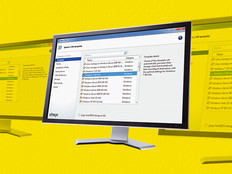The Path to VDI
When Stan Pope, technology services director for Central Michigan University's College of Business Administration, and Gary Wroblewski, Pope's counterpart in CMU's College of Health Professions, wanted to move their respective colleges from server virtualization to virtual desktops, they decided to join forces.
Although their goals and requirements were vastly different, they shared a common desire: to save time, improve manageability and increase flexibility and customer service.
Pope, who has been with CMU for 10 years, started by virtualizing the college's servers using VMware. At the same time, he developed a system to deliver a specific group of applications via Citrix that either couldn't be installed on individual PCs or weren't covered by a sufficient number of licenses. His ultimate goal was to let students access the software they needed on any of the college's 300 computers.
At the same time, Wroblewski, technical services manager at the health professions school, started moving to a virtual desktop infrastructure (VDI), also using VMware. His goal was to better manage a group of highly secure clinical desktops used by faculty, staff and researchers.
Pope and Wroblewski had been collaborating on VMware servers for several years, and when VMware View came along, they both set up trial systems and compared notes. In 2009, they bought the advanced licenses that provided VMware View Composer, and Wroblewski merged his systems with Pope's. They have been collaborating on projects ever since.
By August 2010, both colleges moved out of the pilot phase and into production. The benefits have been striking.
"We can either install the application right on the virtual desktop or virtualize an application and drop it down," Pope explains. "We can respond to requests in a few hours instead of waiting a week or two to do a reimage."
Other groups at CMU are moving to VDI as well. The College of Science and Technology, for example, has about 300 desktops that use Citrix XenDesktop.
"We have an interesting business model that's emerging, where various units on campus are going to other units to get the VDI they need," says Roger Rehm, CMU's vice president of information technology and CIO.
"For example, my central IT group, public labs throughout the school and the library's 300 desktops are using what Stan built, and other colleges are using the Citrix-based model from the College of Science and Technology."
Eventually, all of the roughly 20,000 students on the main campuses and an additional 8,000 online and satellite students will use VDI in some manner, Rehm says.

Eventually all students at Central Michigan University will use VDI in some form, says CIO Roger Rehm.
Photo: Andy Wakeman
When it comes to VDI, it's all about total cost of ownership (TCO) and flexibility, says Chris Wolf, a research vice president at Gartner (see sidebar below).
"In a university setting with a traditional PC environment, you have to schedule rooms based on the type of software needed," he says. "That puts a lot of strain on the IT staff to retrofit rooms and worry about student counts when it comes to connecting students to apps. With VDI, you're just putting students in classrooms or labs without having to worry about what computer hardware or software is in that room."
Cost savings can be significant over time. Most organizations can expect to recoup their investment in three to five years. "Be patient and committed to it," Wolf advises.
Virtually New
Florida Atlantic University's College of Engineering and Computer Science had both unique challenges and unique opportunities when it created a virtual desktop infrastructure in a new building that opened last October.
First, the college's 2,000 students use some of the most complex and customized software for their computer science and engineering applications. Some of the specialties include apps for civil and geomatics engineering, electrical engineering and ocean and mechanical engineering. Second, the college is working to attain the platinum LEED certification for the new building, which means that it must use green materials and technology (including virtualization) whenever possible.
After testing many VDI technologies, Mahesh Neelakanta, director of the college's Technical Services Group, settled on VMware View as a way to virtualize desktops in its computer labs, administrative offices, and faculty and research offices.
"Before we moved to this infrastructure, we would often get last-minute requests from faculty to install a new piece of software in a computer lab, and we would have to install the package manually on each computer, because a lot of engineering software is very custom," Neelakanta says. "And because the machines were so old, we would have faculty and staff not only worried about hard-drive crashes, but about having enough compute power to do their jobs."
Today, the college's computer labs are filled with a mixture of HP gt7725 and t5745 thin clients, Wyse Technology P20 zero clients and EVGA client devices. This makes it simple for the IT staff to deploy new virtual machines quickly.
In the old setup, each lab was software- or department-specific. Now, the same lab can be repurposed instantly. Today, a civil engineering student using a CAD/CAM program might be sitting next to a computer science student using Visual Studio.
Soon, the program will be expanded to let students, faculty and staff access virtual desktops from outside the campus. The VDI effort has been so successful that other colleges in the university are planning similar initiatives over the next two years, Neelakanta says.
Slowly, but Surely
Sometimes budget issues prolong the switch to VDI. That's been the case with the Colorado Community College System. The goal, says Vice President and CIO Julie Ouska, is to ensure that students, faculty and staff at each of 13 colleges statewide have the same basic desktop configuration and aren't slowed down by the older PCs that exist in some faculty areas, staff offices and student labs.
Ouska started a pilot this year using Citrix XenDesktop for about 50 staff members. During the new fiscal year, which began July 1, the pilot will expand to more colleges and include some students and student labs. Eventually, Ouska wants the entire community college system on a standardized virtual desktop infrastructure.
"We'd like to get to the point where our faculty and administrative staff simply go to a website, log in and get their personalized desktop," she explains. "On the student side, we'll eventually get to the point where they will have the same access at home from their desktop PC, notebook or tablet as they would in a student lab."
Long waits for lab machines during peak exam times should subside now that Menlo College has begun to roll out VDI, says CIO Raechelle Clemmons.
Photo: John Lee
The benefits for both groups will be significant. For example, the college has many adjunct faculty who are prohibited by state law from installing state-owned software on a personal PC. With virtualization, the college can provide whatever software the adjunct faculty need for teaching, such as AutoCAD or Photoshop. Students will also have access to software they need that they might not be able to afford otherwise.
Raechelle Clemmons, CIO at Menlo College in Atherton, Calif., wanted to implement VDI at the small business college when she arrived two years ago, but until recently, she couldn't justify the expense for just the handful of student labs the 600-student college operates.
"I came from a much larger public institution that was already looking at a virtual computing lab, so I knew the benefits well," Clemmons says. "But since this is such a small school, I didn't think VDI would make sense until we could use it with all of our users – not just students, but faculty and staff also."
The student labs were in dire need of a change. Because the school is so small, it buys a small number of software licenses for specialized software that might be used in only a few classes. A 30-seat lab might have five stations dedicated to one piece of software, another five stations reserved for something else. In addition to management challenges for the school's small IT staff, students had to find an open lab that had PCs with the software they needed, and then find an available PC with that software. During peak times, such as during midterms and finals, long waits for machines were common.
Last year, Clemmons finally decided that the technology had matured enough to allow everyone at the school to benefit from VDI. Since the school already used some VMware technology, that became the technology of choice.
In December 2010, the IT staff piloted VDI with 55 virtual machines. VMs were available mostly in student labs, with a few scattered among the administrative staff, where standard desktops had been experiencing problems with syncing and VPN access.
161%
The estimated return on investment for an organization switching 3,000 PC users to virtual desktops
SOURCE: Citrix XenDesktop ROI Calculator
Most of the labs are still using PCs, although they will be upgraded to thin clients as they age. One lab is being retrofitted with all thin clients. During the coming fiscal year, the school will add another 200 virtual machines, with the remainder slated for the following year, for a total of about 380.
The IT department uses one piece of software to create application layers, which can be combined to create any type of unique desktop a user might need. Students using the virtual machines can then launch the VMware View client, which brings up a virtual desktop on any device, in any location.
"We want our users to be able to access a virtual desktop on their own notebooks or tablets from any location using the VMware View Connection Server," Clemmons explains. "It's all about access."
The TCO of VDI
Management and flexibility benefits aside, VDI can be a real cost-saver for a college or university that does its homework. With virtual desktops, for example, organizations don't have to replace aging PCs. In addition, the soft costs saved in IT staff hours can really add up.
The issue, says Chris Wolf, a Gartner research vice president, is that it can take a few years for the cost savings to materialize. For example, Gartner estimates that a typical virtual desktop costs almost one and a half times more than the cost of a physical desktop.
Although that may sound discouraging, Gartner has found that early adopters with a commitment to streamlining their application delivery architecture as part of their VDIimplementation are saving about 10 percent overall. For many organizations, that can translate into millions of dollars per year in savings, Wolf says.
"The key is to look at the business case and the requirements up front and make sure you haven't left anything important out of the calculations," Wolf says.
Doing your homework can pay off. At Florida Atlantic University's College of Engineering and Computer Science, Director of Technical Services Mahesh Neelakanta says he expects to save at least 50 percent on desktop costs. Additional savings will be accrued by reallocating some of the computer power available during the evening hours to researchers and graphics students, who need additional power to run complicated simulations.
And Raechelle Clemmons, CIO of Menlo College, is confident that VDI will save the college significant money.
"We're deploying to 300-plus users at an annual cost per virtual desktop that is well under $300, pretty much the same as a physical PC," she says. "That's not the real news, because the true cost of a desktop per year – when you factor in the all-important staff time and operating expenses – is actually $1,120 by our estimates, while the new virtual desktops are coming in at an estimated $735 each."







